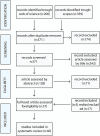Green space and the health of the older adult during pandemics: a narrative review on the experience of COVID-19
- PMID: 37601191
- PMCID: PMC10433209
- DOI: 10.3389/fpubh.2023.1218091
Green space and the health of the older adult during pandemics: a narrative review on the experience of COVID-19
Abstract
Introduction: Aging is an inevitable process that leads to changes in various dimensions of older adult life, including physical, psychological, and social aspects. Unfortunately, older adults are more susceptible to health problems caused by adverse experiences such as the Corona outbreak.
Aim: The current study examines the lived experience of older adults in facing the conditions of the Corona epidemic to see how green spaces at various scales can influence the physical and mental health of this group.
Method: Relevant articles published, from 2019 to February 17, 2023, were searched using in the Scopus and Web of Science databases. Eligible studies published in English and all studies passed a quality evaluation.
Result: In the final search, 40 articles were selected and analyzed. The majority of studies conducted during the pandemic categorized the impact of green spaces on the health of older adults into three main categories: Place-based attribute, Process, and Function.
Conclusion: The findings of this study demonstrated that people were using private green spaces (gardens, balconies, etc.), small local green public spaces, sitting and gathering spaces in the neighborhood, nearby open spaces, and urban green-blue spaces throughout the epidemic era. They visited green spaces outside the city and urban areas, including urban gardens, agricultural areas, forestlands, and pastures. In this research, we investigated the characteristics of these spaces and classified them into four physical categories: urban landscape, land use, activity, movement, and accessibility. The results showed that exposure to nature or green space improved physical and mental health and increased attention and decision-making quality in older people. We have proposed design implications recommendations for crises to improve safety, security, and social capital by increasing the safe access of older adults to diverse and high-quality green spaces on different scales, which will ultimately enhance the physical and mental health of people in different age groups.
Keywords: COVID-19; green space; health; narrative review; older adults.
Copyright © 2023 Tabrizi, Lak and Moussavi.A.
Conflict of interest statement
The authors declare that the research was conducted in the absence of any commercial or financial relationships that could be construed as a potential conflict of interest.
Figures
Similar articles
-
Relationship between urban green space and mental health in older adults: mediating role of relative deprivation, physical activity, and social trust.Front Public Health. 2024 Aug 29;12:1442560. doi: 10.3389/fpubh.2024.1442560. eCollection 2024. Front Public Health. 2024. PMID: 39267636 Free PMC article.
-
Evaluation of urban green space per capita with new remote sensing and geographic information system techniques and the importance of urban green space during the COVID-19 pandemic.Environ Monit Assess. 2022 Aug 3;194(9):633. doi: 10.1007/s10661-022-10298-z. Environ Monit Assess. 2022. PMID: 35922695 Free PMC article.
-
"I Would Never Come Here Because I've Got My Own Garden": Older Adults' Perceptions of Small Urban Green Spaces.Int J Environ Res Public Health. 2019 Jun 5;16(11):1994. doi: 10.3390/ijerph16111994. Int J Environ Res Public Health. 2019. PMID: 31195595 Free PMC article.
-
Older people and nature: the benefits of outdoors, parks and nature in light of COVID-19 and beyond- where to from here?Int J Environ Health Res. 2022 Jun;32(6):1329-1336. doi: 10.1080/09603123.2021.1879739. Epub 2021 Mar 7. Int J Environ Health Res. 2022. PMID: 33682531 Review.
-
A Scoping Review of How Income Affects Accessing Local Green Space to Engage in Outdoor Physical Activity to Improve Well-Being: Implications for Post-COVID-19.Int J Environ Res Public Health. 2020 Dec 12;17(24):9313. doi: 10.3390/ijerph17249313. Int J Environ Res Public Health. 2020. PMID: 33322829 Free PMC article.
Cited by
-
Perceived urban green spaces and youth mental health in the post-COVID-19 era.Front Public Health. 2024 Feb 7;12:1265682. doi: 10.3389/fpubh.2024.1265682. eCollection 2024. Front Public Health. 2024. PMID: 38384876 Free PMC article.
-
Housing insecurity pathways to physiological and epigenetic manifestations of health among aging adults: a conceptual model.Front Public Health. 2025 Jan 23;13:1485371. doi: 10.3389/fpubh.2025.1485371. eCollection 2025. Front Public Health. 2025. PMID: 39916715 Free PMC article. Review.
-
The Silver Agri Age project in Italy: a Montessori-inspired social intervention with older adults with mild cognitive impairment. Single-group pre-post pilot study protocol.Front Public Health. 2025 May 16;13:1561263. doi: 10.3389/fpubh.2025.1561263. eCollection 2025. Front Public Health. 2025. PMID: 40453497 Free PMC article. Clinical Trial.
-
The impact of urban agglomeration planning on depression in older adults.Front Public Health. 2024 Dec 17;12:1456729. doi: 10.3389/fpubh.2024.1456729. eCollection 2024. Front Public Health. 2024. PMID: 39741935 Free PMC article.
-
GrimAge is elevated in older adults with mild COVID-19 an exploratory analysis.Geroscience. 2024 Aug;46(4):3511-3524. doi: 10.1007/s11357-024-01095-2. Epub 2024 Feb 15. Geroscience. 2024. PMID: 38358578 Free PMC article.
References
-
- Adjie HK, Bahari DM. Examining Indonesian Government Strategies in the aviation sector post COVID-19 pandemic. J Contempor Govern Publ Pol. (2021) 2:79–91. 10.46507/jcgpp.v2i2.45 - DOI
-
- Oxford Dictionary. Oxford English Dictionary. Simpson J, Weiner E (1989). p. 3.
Publication types
MeSH terms
LinkOut - more resources
Full Text Sources
Medical





